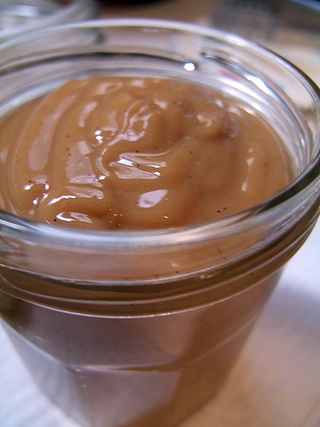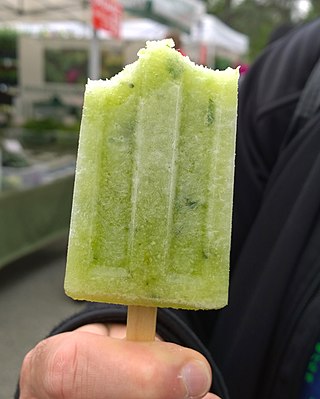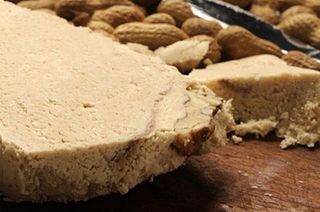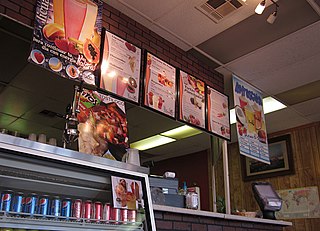
Condensed milk is cow's milk from which water has been removed. It is most often found with sugar added, in the form of sweetened condensed milk, to the extent that the terms "condensed milk" and "sweetened condensed milk" are often used interchangeably today. Sweetened condensed milk is a very thick, sweet product, which when canned can last for years without refrigeration if not opened. The product is used in numerous dessert dishes in many countries.

M&M's are color-varied sugar-coated dragée chocolate confectionery, each of which has the letter "m" printed in lower case in white on one side, consisting of a candy shell surrounding a filling which varies depending upon the variety of M&M's. The original candy has a semi-sweet chocolate filling which, upon introduction of other variations, was branded as the "plain, normal" variety. Peanut M&M's, which feature a peanut coated in milk chocolate, and finally a candy shell, were the first variation to be introduced, and they remain a regular variety. Numerous other variations have been introduced, some of which are regular widespread varieties while others are limited in duration or geographic availability. M&M's are the flagship product of the Mars Wrigley Confectionery division of Mars, Incorporated.

Dulce de leche, caramelized milk, milk candy, or milk jam is a confectionery popular in Latin America, France, Poland, and the Philippines prepared by slowly heating sugar and milk over several hours. The substance takes on a spreadable, sauce-like consistency and derives its rich flavour and colour from non-enzymatic browning. It is typically used to top or fill other sweet foods.

See's Candies is an American manufacturer and distributor of candy, particularly chocolates. It was founded by Charles See, his wife Florence, and his mother Mary in Los Angeles, California in 1921. The company is now headquartered in South San Francisco, California. See's kitchens are located at its headquarters and maintained at its original factory in Los Angeles, where there are also retail shops. It also has an office in Carson, California. The company has been owned by Warren Buffett's Berkshire Hathaway Corporation since 1972.
Brach's is a candy and sweets brand of Ferrara Candy Company.

Chabacano metro station is a Mexico City Metro transfer station in the Cuauhtémoc borough of Mexico City. It is served by Lines 2, 8 and 9. It is a combined underground and at-grade station whose platforms are distributed into two side platforms and one island platform—the Spanish solution layout.

Panela or rapadura is an unrefined whole cane sugar, typical of Latin America. It is a solid form of sucrose derived from the boiling and evaporation of sugarcane juice. Panela is known by other names in Latin America, such as chancaca in Chile, Bolivia, and Peru, piloncillo in Mexico. Just like brown sugar, two varieties of piloncillo are available; one is lighter (blanco) and one darker (oscuro). Unrefined, it is commonly used in Mexico, where it has been around for at least 500 years. Made from crushed sugar cane, the juice is collected, boiled, and poured into molds, where it hardens into blocks. It is similar to jaggery, which is used in South Asia. Both are considered non-centrifugal cane sugars.

Frango mints are a brand of chocolate truffles first created for the Frederick & Nelson department stores. Traditionally flavored with mint and widely popularized by the Marshall Field and Company department store, they were later produced and distributed by Macy's department stores. Frango is also the brand name of a line of various other related food products.

Farley's & Sathers Candy Company was created as an umbrella company to roll up many small companies, brands and products under a common management team. The confectionery business segment is made up of many small companies, often with intertwined relationships and histories.
Pelon Pelo Rico is a popular tamarind-flavored candy that is manufactured in Jalisco, Mexico, under the Lorena brand, by the Hershey Company, which is headquartered in Pennsylvania in the United States. The product originated in Guadalajara. Pelón Pelo Rico was created by the candy maker Grupo Lorena and released to the market in 1985. In 2004 the Hershey Company bought Lorena and its brands.

An ice pop is a liquid/cream-based frozen dessert on a stick. Unlike ice cream or sorbet, which are whipped while freezing to prevent ice crystal formation, an ice pop is frozen while at rest, becoming a solid block of ice. The stick is used as a handle to hold it. Without a stick, the frozen product would be a freezie.

Chamoy is a variety of savory sauces and condiments in Mexican cuisine made from pickled fruit. Chamoy may range from a liquid to a paste consistency, and typically its flavor is salty, sweet, sour, and spiced with chilies.

Mantecol is the brand name of a typical dessert of the cuisine of Argentina, a sort of semi-soft nougat made from peanut butter. It was originally created and marketed in the 1940s by the confectionery company Georgalos, founded by a Greek immigrant, Miguel Georgalos, who took inspiration from a dessert in Greek cuisine, halva.

Havanna Holding S.A. is an Argentine manufacturer of food products, mostly known for its alfajores. The firm was founded in 1948 by Benjamín Sisterna, Demetrio Elíades, and Luis Sbaraglini and began its activities as a producer of alfajores in the city of Mar del Plata.

Carlos V is a brand of Mexican chocolate bar, produced since the 1970s in Mexico and launched in 2005 in the United States by Nestlé.

Guava jelly, guava jelly, or guava paste, is a Hispanic American confection made with guava pulp and panela, which is consumed abundantly throughout Colombia, Costa Rica, Ecuador, Panama and Venezuela. Similar confection can be produced from other fruits like banana and coconut.

Cuerito is pig skin from Mexican cuisine, Venezuelan cuisine and Spanish cuisine. Cuero is the Spanish-language word for skin, leather or hide, so cueritos means "little skins". They are usually pickled in vinegar and can be made with a spicy sauce. The vinegar can be seasoned with pineapple, dulce macho (piloncillo), cloves, peppercorns, chile de árbol and oregano. There are also family recipes.

A Frutería or Mexican juice bar is a juice bar that primarily serves Mexican desserts, beverages, antojitos and other popular Mexican snack foods. Mexican juice bars are popular establishments in many parts of Mexico and more recently in Mexican American communities in South-Western United States.

Chamoyada is a sweet and spicy type of shaved ice, or raspado, drink prepared with fruit and flavored with chamoy. It is a part of Mexican cuisine, and is also common in regions of the United States with significant Mexican-American populations. The drink is most commonly prepared with mango sorbet or mango-flavored shaved ice, and thus is sometimes also called a mangonada or chamango.















